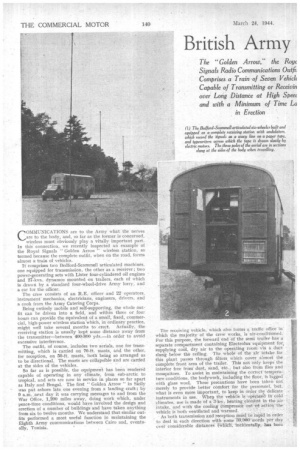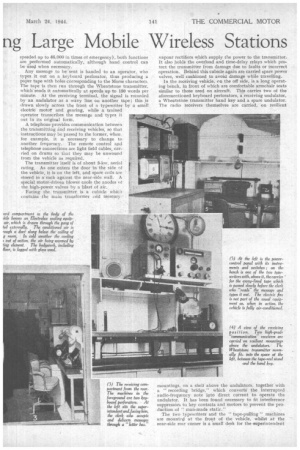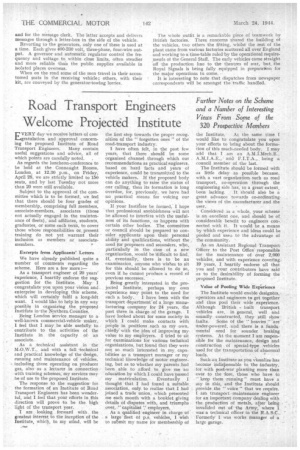British Army ng Large Mobile Wireless Stations
Page 26

Page 27

Page 28

If you've noticed an error in this article please click here to report it so we can fix it.
COMMUNICATIONS are to the Army what the nerves are to the body, and, so far as the former is concerned, wireless must obviously play a vitally important part. In this connection, we recently inspected an example of the Royal Signals " Golden Arrow " wireless station, so termed because the complete outfit, when on the road, forms almost a train of vehicles.
If comprises two Bedford-Scammell articulated machines, one equipped for transmission, the other as a receiver: two power-generating sets with Lister four-cylindered oil engines and 27-kva. dynamos mounted on trailers, each of which is drawn by a standard four-wheel-drive Army lorry, and a car for the officer.
The crew consists of an R.E. officer and 22 operators, instrument mechanics, electricians, engineers, drivers, and a cook from the Army Catering Corps.
Being entirely mobile and self-supporting, the whole outfit can he driven into a field, and within three or four hours can provide the equivalent of a small, fixed, commercial, high-power wireless station which, in ordinary practice, might well take several months to erect. Actually, the receiving station is usually kept some distance away from the transmitter—between 400.00 yds.—in order to avoid excessive interference.
The outfit, of course, includes two aerials, one for transmitting, which is carried on 70-ft. masts, and the other, for reception, on 50-ft. masts, both being so arranged as to he directional. The masts are collapsible and are carried at the sides of the vehicles.
So far as is possible, the equipment has been rendered capable of operating in any climate, from sub-arctic to tropical, and sets are now in service in places so far apart as Italy and Bengal. The first " Golden Arrow " in Sicily was put ashore late one evening from a landing craft; by 9 a.m..next day it was carrying messages to and from the War Office, 1,200 miles away, doing work which, under peace-time conditions, would have involved the design and erection of a number of buildings and have taken anything from six to twelve months. We understand that similar outfits performed a most useful function in maintaining the Eighth Army communications between Cairo and, eventually, Tunisia.
The receiving vehicle, which also forms a traffic office in which the majority of the crew works, is air-conditioned. For this purpose, the forward end 'di the semi trailer -has a separate compartment containing Electrolux equipment -for. supplying cool, dry air to the operating room via a duct slung below the ceiling. The whole of the air intake for this plant passes through filters. which cover :almost the complete front area of the trailer, This ndt only keeps. the interior free frOm" dust, Sand, etc., but also from flies and mosquitoes. To assist in maintaining the correct.ternperature conditions, the bodywork, including the floor, is lagged • with glass wool. These precautions have been taken not merely to provide better comfort for the personnel, -but, what is even more important, to keep in order the delicate instruments in use. Whet) the vehicle is :rated in cold climates, use is made of a 3-kw. heating,elernent in the air intake, and with the cooling compressor 'out Of: action thevehicle is'both ventilated and warmed.
As both transmission and reception rads( be 'rapid in order to deal in each direction with some 39,000 words per day over considerable distances .(Witicli, 'incidentally, has been
speeded up to 40,000 in times of emergency), both functions are performed automatically, although hand control can be used when necessary.
Any message to be sent is handed to an operator, who types it out on a keyboard perforator, thus producing a paper tape with holes corresponding to the Morse characters. The tape is then run through the Wheatstone transmitter, which sends it automatically at speeds up to 150 words per minute: At the receiving terniinal, the signal is recorded by an undulator as a wavy line on another tape ; this is drawn slowly across the front of a typewriter by a small electric motor and gearing, while a trained operator transcribes the message and types it out in its original form.
A telephone provides communication between the transmitting and receiving vehicles, so that instructions' may be passed to the former, when. for example, it is necessary to change to another frequency. The remote control and telephone connections are light field cables, carried on drums so that they may be unwound from the vehicle as required.
The transmitter itself is of about 3-kw. aerial rating. As one enters the door in the side of the vehicle, it is on the left, and spare coils are stored in a. rack against the near-side wall. A special motor-driven blower cools the anodes of the high-power valves by a blast of air..
Facing the transmitter is a cubicle which contains the main transformer and mercury vapour rectifiers which supply the power to the transmitter. It also holds the overload and time-delay relays which protect the transmitter from damage due to faults or incorrect operation. Behind this cubicle again are carried spare power valves, well cushioned to avoid damage while travelling.
In the receiving vehicle, on the off side, is a long operating bench, in front of which are comfortable armchair seats similar to those used on aircraft, This carries two of the aforementioned keyboard perforators, a receiving undulator, a Wheatstone transmitter hand key and a spare undulator. The radio receivers themselves are carried, on resilient
mountings, on a shelf above the uudulators, together with a " recording bridge," which converts the interrupted audio-frequency note into direct current to operate the andulator. It has been found necessary to fit interference suppressors to key contacts and motors to prevent the production of " man-made static."
The two typewriters and the " tape-pulling " machines are mounted at the front of the vehicle, whilst at the near-side rear corner is a 'small desk for the superintendent and for the message clerk. The latter accepts and delivers messages through a letter-box in the side of the vehicle.
Reverting to the generators, only one of these is used at a time, Each gives 400-230 volt, three-phase, four-wire output. A governor and automatic regulator control the frequency and voltage to within close limits, often steadier and more reliable than the public supplies available in isolated places overseas.
When on the read some of the men travel in their accustomed seats in the receiving vehicle; others, with their kit, are conveyed by the generator-towing lorries. The whole outfit is a remarkable piece of teamwork by f3ritish factories. Three concerns shared the building of the vehicles, two others the fitting, whilst the rest of the . plant came from various factories scattered all over England and working to a time-table ruled by the operational requirements of the General Staff. The early vehicles came straight off -the production line to the theatres of .war, but. the Royal Signals is being fully equipped in preparation for the major operations to come. • It is interesting to note that dispatches from newspaper correspondents will be amongst thetraffic handled.




















































